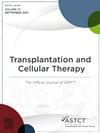血浆核小体水平与清髓异基因造血干细胞移植后急性移植物抗宿主病的风险:一项单中心队列研究
IF 3.6
3区 医学
Q2 HEMATOLOGY
引用次数: 0
摘要
背景:循环核小体代表细胞死亡,这是同种异体造血干细胞移植(alloo - hsct)后急性移植物抗宿主病(GVHD)的一个特征。目的:探讨血浆核小体水平是否与急性GVHD的预后有关。研究设计:我们检测了2015年6月至2018年8月期间接受清髓性同种异体造血干细胞移植的131例患者的循环核小体水平。对移植前(中位数为-23天)和同种异体造血干细胞移植后+7、+14和+28天左右获得的储存血浆样本,使用定量光度三明治- elisa进行测量。结果:血浆中位核小体水平保持不变,直到第28天,它们显著增加(与所有其他测量时间相比p < 0.001)。第28天的血浆核小体水平与后期II-IV级急性GVHD的风险呈负相关(比值为0.86 / 5任意单位(AU)增加[95% CI: 0.66-0.99], p = 0.03),校正急性GVHD的危险因素后也是如此(比值为0.78 / 5任意单位增加[95% CI: 0.56-0.96], p = 0.01)。我们没有发现移植前或移植后第7天或第14天前后核小体血浆水平与随后发生II-IV级急性GVHD的风险之间存在关联。在第28天,我们观察到核小体、ST2和c反应蛋白呈正相关(Spearman ρ = 0.522,p < 0.001;Spearman ρ = 0.386,p < 0.001;分别)。结论:HSCT术后+28天血浆核小体水平较低与随后急性GVHD的高风险相关。需要进一步的研究来验证循环核小体作为急性GvHD的预后生物标志物。本文章由计算机程序翻译,如有差异,请以英文原文为准。
Plasma Nucleosome Levels and Risk of Acute Graft-Versus-Host Disease After Myeloablative Allogeneic Hematopoietic Stem Cell Transplantation: A Single-Center Cohort Study
Circulating nucleosomes are representative of cell death, which is a feature of acute graft-versus-host disease (GVHD) following allogeneic hematopoietic stem cell transplantation (allo-HSCT). We explored whether plasma nucleosome levels were prognostic for acute GVHD. We examined the level of circulating nucleosomes in 131 patients who underwent a myeloablative allo-HSCT between June 2015 and August 2018. The measurements were made using quantitative photometric sandwich-ELISA on stored plasma samples obtained pretransplantation (at a median of day –23) and around days +7, +14, and +28 after allo-HSCT. The median plasma nucleosome level remained constant until day +28, where they increased significantly (P < .001 compared to all other times of measurement). The plasma nucleosome level at day +28 was inversely associated with the risk of later grade II to IV acute GVHD (odds ratio [OR] 0.86 per 5 arbitrary unit [AU] increase [95% confidence intervals (CI): 0.66 to 0.99], P = .03), also after adjustment for risk factors of acute GVHD (OR 0.78 per 5 AU increase [95% CI: 0.56 to 0.96], P = .01). We found no support for an association between the plasma level of nucleosomes measured pretransplantation or around day +7 or +14 and the risk of subsequent grade II to IV acute GVHD. We observed a positive correlation between nucleosomes, suppressor of tumorigenesis 2, and C-reactive protein at day +28 (Spearman's ρ = 0.522, P < .001; and Spearman's ρ = 0.386, P < .001; respectively). A lower level of plasma nucleosomes at day +28 after HSCT was associated with a higher risk of subsequent acute GVHD. Additional studies are needed to validate circulating nucleosomes as a prognostic biomarker of acute GVHD.
求助全文
通过发布文献求助,成功后即可免费获取论文全文。
去求助
来源期刊

Transplantation and Cellular Therapy
Medicine-Hematology
CiteScore
7.00
自引率
15.60%
发文量
1061
审稿时长
51 days
 求助内容:
求助内容: 应助结果提醒方式:
应助结果提醒方式:


